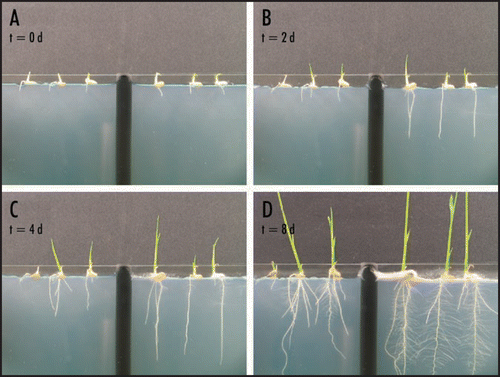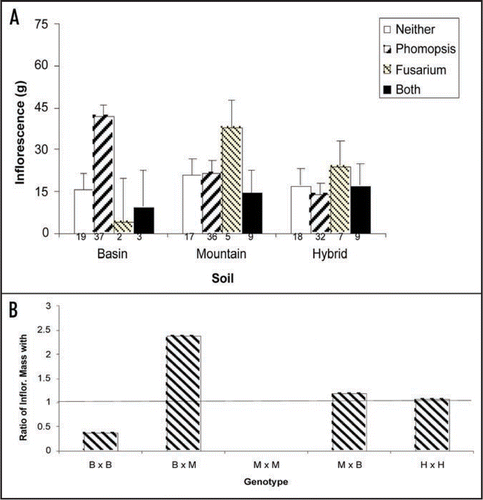Figures & data
Figure 1 Growth of nonsymbiotic (left side of each image) and symbiotic (right side of each image) rice seedlings. Seedlings were placed on agar medium (1.5% agar, 1X hoaglands solution, 8 mM Ca2Cl) sandwiched between glass plates and grown under constant light (daylight balanced fluorescent bulbs, 22 µmol m−2 s−1) for 8 days (A–D). Growth of the endophyte (F. culmorum) and plant inoculations were performed as previously described.Citation9

Figure 2 Ratio of root and shoot growth in symbiotic and nonsymbiotic rice plants. Data are based on the average linear root and shoot growth of three symbiotic (dashed line) and three nonsymbiotic (solid line) plants. The arrow indicates the times of root hair development. Differences through time and between symbiotic and non-symbiotic plants were statistically significant (repeated measures ANOVA, between-subjects effect p = 0.03, within-subjects effect [quadratic] = 0.03, within-subjects interaction [quadratic] = 0.01)
![Figure 2 Ratio of root and shoot growth in symbiotic and nonsymbiotic rice plants. Data are based on the average linear root and shoot growth of three symbiotic (dashed line) and three nonsymbiotic (solid line) plants. The arrow indicates the times of root hair development. Differences through time and between symbiotic and non-symbiotic plants were statistically significant (repeated measures ANOVA, between-subjects effect p = 0.03, within-subjects effect [quadratic] = 0.03, within-subjects interaction [quadratic] = 0.01)](/cms/asset/84d835ed-54fe-44e3-897b-f035b73d2edc/kcib_a_10907821_f0002.gif)
Figure 3 Interaction between endophyte, sagebrush genotypes, soil and plant reproduction. (A) Plants were harvested at 3 years of age, divided into roots, shoot and reproductive tissue, dried at 65°C for = days and then the dried mass of each category was determined ± 1 mg. Data were analyzed using a MANOVA. Means and standard errors are shown. (B) Ratio of Inflorescence mass when plants are grown with and without Alternaria sp. This endophyte enhances only hybrid reproduction. Basin, Mountain and Hybrid plant varieties are designated B, M and H, respectively.
